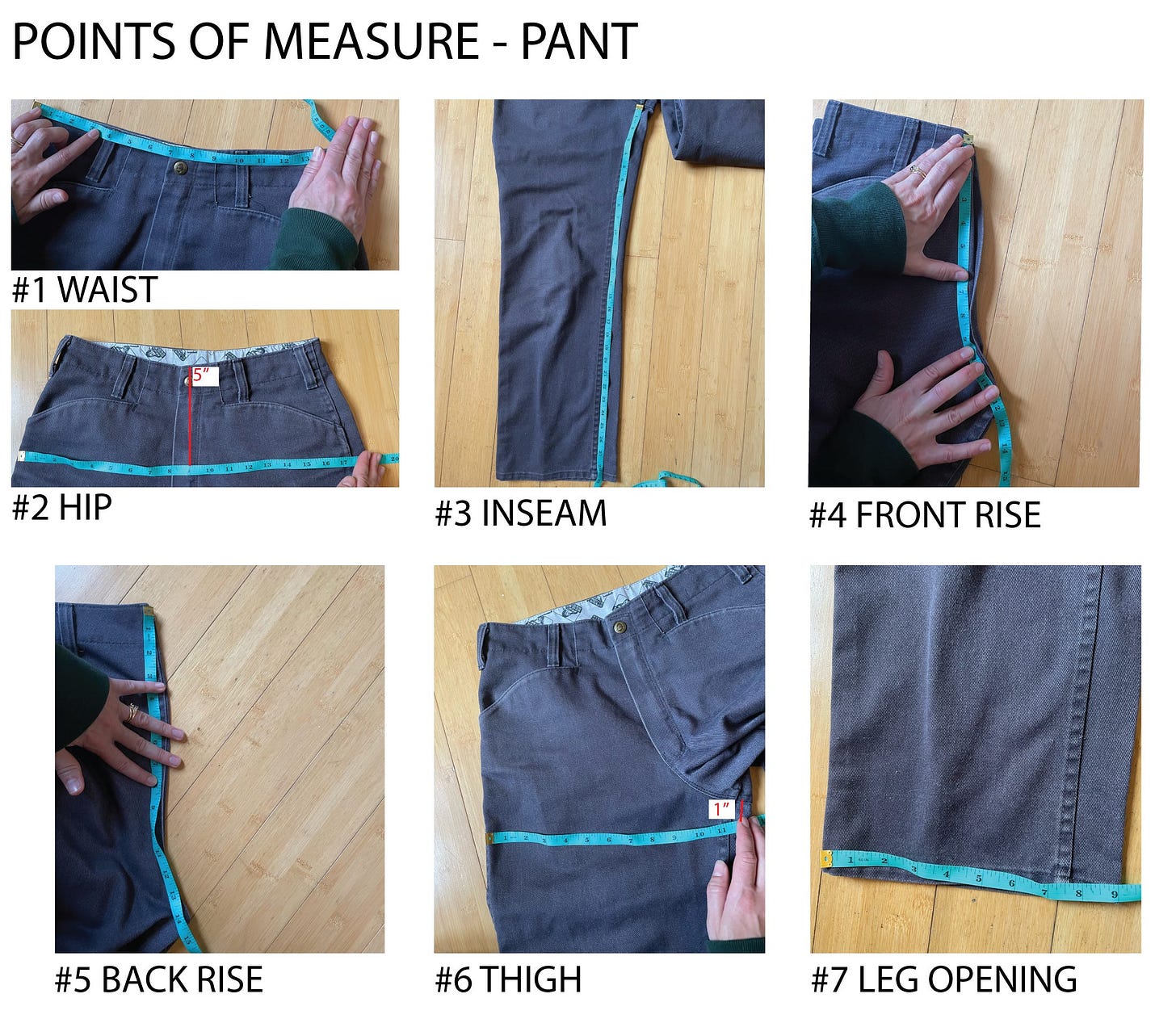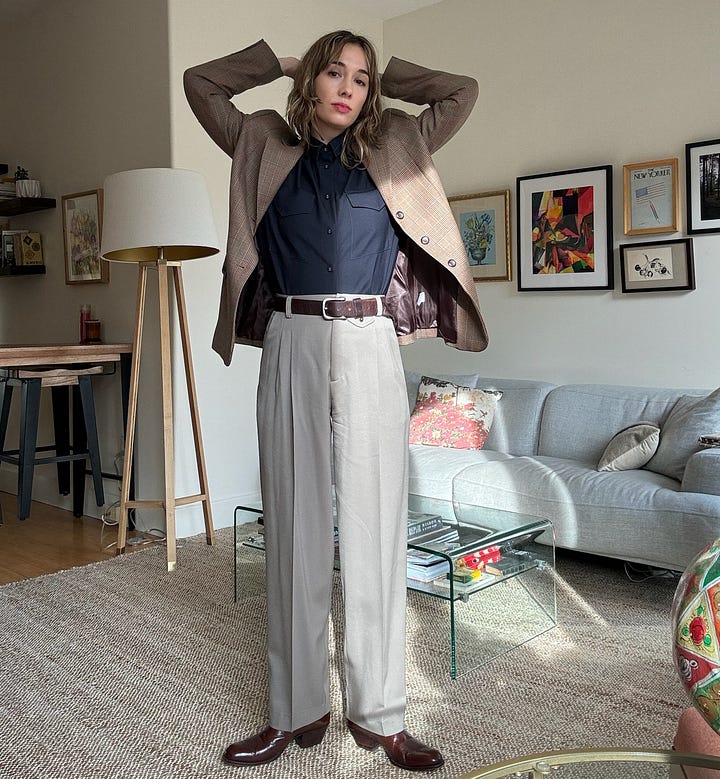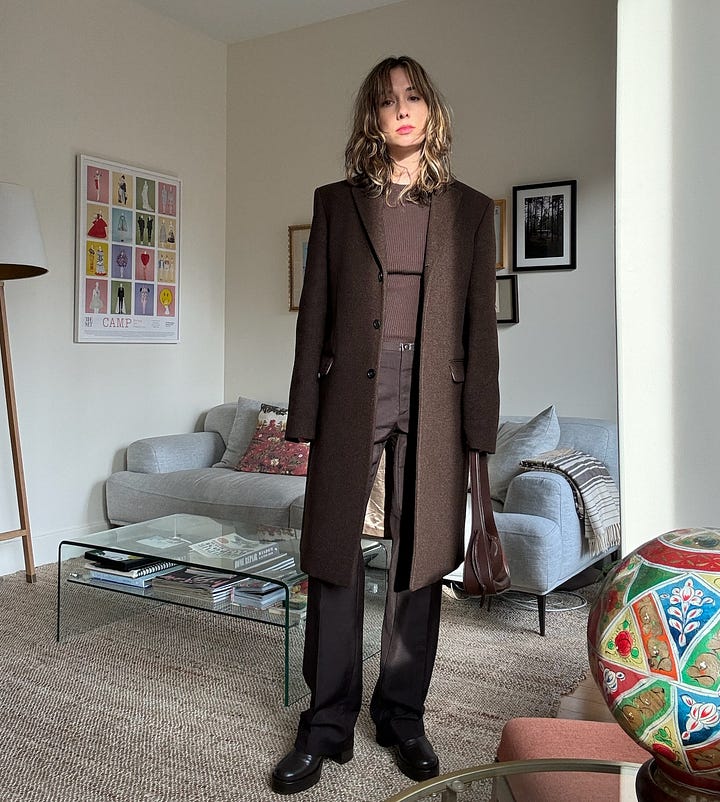The temperamental nature of trousers, during temperamental temperatures.
Keep your pants on! Focus on waist placement, hip shape & rise length for stupendously-fit wool trousers.

The hardest garment to fit and form properly is the pant. As someone attempting to flat pattern my own pair of pants for my brand, Villeine (mind you, this is a long-term project, with the hopes of even small success—I am not a patternmaker), I can certainly attest to the difficulty of developing the pant. And to quote my friend and former coworker, Liesel, an experienced patternmaker & sewist: “the pant is the least intuitive garment.”
For the main fit of a pant, you’ve got two pattern pieces: the front and back pant (you cut two of each to form pant legs), doing all the work, and these two shapes interact with each other at every point/angle/curve. If you reduce the rise, the crotch point will be impacted, as will the waist placement or width; and then all of the sudden your hip measurement changes, too. Every measurement and shape alteration affects those around them. It’s no wonder it can feel like a sh*tshow to find your perfect fit trouser and how, when you do, you often want to buy them in every color.

That being said, I’m going to try and help you find / better understand what makes a good-fitting pant because I’m a big fan of trousers—as you may know by my former posts where I’ve been proponent for both chinos and work pants. Maybe it’s a shift in my personal style but I find trousers more accessible toward achieving a solid outfit versus jeans these days. And this time of year I’m donning a multitude of wool trousers as they are naturally the warmest.
Let’s examine the big three fit features in order to find your best trouser, keeping in mind all three influence one another:
Part one: Desired waist placement
Part two: Hip shape
Part three: Rise/crotch length
While pant length / inseam, and leg shape are certainly important variables, they fall into the aesthetic realm and are therefore the last (and most fun) elements to consider for your perfect pants.
On waist placements.
Regardless of whatever waist placement you’re after, I advise avoiding straight waistbands on pants. Straight waistbands are a waistband style defined by their name: they are cut as a straight rectangle. They work fine for some skirt silhouettes—for instance when you want a classic fit-and-flare—but on a pant, you encounter the issues mentioned above where no fit feature stands alone. In the case of a straight waistband pant, the rise is especially consequential, and given the rigidity of the straight cut waist, can create a sort of front diaper effect. Straight waistbands are less flexible on the body, based on the fabric grainline and due to their literal straight cut; they don’t contour the body or utilize bias (a 45 degree angle with natural “give”, even in a non-stretch woven) of the fabric.
You can usually spot a straight waistband just by how straight across it sits on the body. And when it’s off the body, the front waist doesn’t “dip” below the back waist, and there is no curve. Note that straight waistband pants are much less common now than before the 1990s and earlier, so you don’t have to be too vigilant about eliminating them from your trousers search, (unless you’re shopping vintage).

High-waisted:
If you’re looking for a high-waisted pant and want a little drama in your life, a double pleated front is a great style to try out. I finally watched Oppenheimer recently, and found myself sartorially focused on how good Cillian Murphy’s wool trousers were: high waisted, double pleated, snatched!!!
But flat front works too in high-waist, only keep in mind it will be less forgiving, especially to a full belly, if the hip shape is too narrow or not curved enough. So, for part two: make sure the pants’ hip shape is either a curved enough shape to accommodate all that over-the-hips coverage, or the pant is generally fuller in shape (pleated or wide).
Part 3 & last fit note for a high-waisted pant is to look for a long rise, front and back—even if you want the crotch fitted, the sheer length of the measurement will obviously need to be longer than that of a lower-waisted pant. Again, measuring off of an existing pant is always the best method because everyone likes different amounts of room/ease in the crotch. Reminder: if you don’t have a reference garment, know your body measurements and add at least 1” of ease to all fit measurements from body→garment.


Style with: High waisted pants are best worn back with something tucked in or cropped to meet at the waistline—otherwise why go through all the work of wearing something fitted at the waist?!
Wool construction: Avoid a half-lined pant for high-waisted—it’s too bulky around your middle. Therefore you’ll want your fabric choice to be worsted wool or gabardine (longer yarns so they’re softer, with more drape) since it’s touching the body directly. Fly shields /extensions get quality tailoring bonus points. If unlined, seams throughout leg and rise should be pressed open for best garment drape and ease of tailoring.
Mid-waist placement:
If you want the waist placement just below your bellybutton, a single or double pleated front pant is still an exceptional option. There are also flat front, or crease-front styles which execute beautifully in mid-rise pants. As for part 2: the hips, same as above: ensure there is either enough fullness, or a curved hip shape—but less fullness is needed than for a high-waisted pant, since mid-waist covers less hip ground. Part 3: If you don’t want a snug crotch+rise fit, expect to add a few inches to the rise measurement from body→garment. Note that fitted/snug hips and a fitted crotch don’t pair well with pleated pants, since the whole point of a pleat is to add fullness. I’d say mid-waistline placement is the easiest to work with as far as general pant shape; wide leg, straight, pegged, flared, go wild.


If you want a mid-to-high-waisted trouser fitted throughout the hips, rise and crotch, you’re gonna need some amount of stretch in the fabric (like my pants above).


Style with: Mid-rise trousers are the most versatile: I think you can still get away with tucking in your woven tops, without elongating your torso in an unappealing way, or wear a sweater/blouse that meets at your pant waistline. As you enter the lower-waist zone, your top partially covering your pant looks better than with high-waisted—just make sure if the top is longer, that its hem opening ISN’T TIGHT—you don’t want your shirt to “cup” the hips with pants underneath.
Wool construction: Unlined or a half-lining is okay, thus woolen yarns (shorter & often itchier) are good to go with that protective lining. More interior construction details are same as above: fly shields /extensions get quality tailoring bonus points. A waistband curtain tailored construction works well for many wool pants. This classic old-school construction keeps the inside neat, and prevents the waistband from collapsing with wear. Like any wool pant when unlined, interior seams at leg and rise should be pressed open.


Low waist placement.
I prefer a low-waisted wool trouser to be the most relaxed fit of all waist placements. For part 2: with a low waist placement, you don’t need a lot of hip shaping (minimal hip curve to none). Like with jeans, low-waisted & short rise trousers can give off a very ‘00s vibe so beware of that if it’s not the look you’re going for. Part 3: I’d generally say a dropped crotch is the most approachable in a lower waist placement pant. And good news for warmth: wide leg and heavier fabrics work great in a low waist placement trouser.


Style with: A fitted top goes best with a low-waisted trouser: think rib knit, mesh, snug T-shirt. That, or go big-on-big: if it’s a wide leg pant, wear a boxy, loose-hemmed shirt or sweater over top. *OR unbutton your button down from hem to waist, like Greta Lee in Past Lives, my inspiration for the above outfit.*
Wool construction: Half-lining or unlined is okay; it’s all fabric-dependent. Same as above with fly shields as extra good. And again, a waistband curtain construction keeps a nice, structured waist. Same as above, again on needing interior seams throughout leg and rise pressed open (binding or overlocked edges is fine).
Leg shape + pant length, & other notes.
Once you’ve tackled the big three (waist placement, hip shape, & rise length) for your desired pant fit, you’ll want to consider pant leg shape, which I touched on a bit, above~~but your pant break (or lack thereof) choice will be most important for styling. Refresher from when we first discussed pant lengths, a pant break is the fold/creasing of fabric that forms at the front of your pant leg when you are standing, just above your shoe. The relationship of shoe to pant is a deeply important one lol. I find that for any trouser with a break, a pointed toe, short heel, or thick-to-wider-soled flat shoe work best—otherwise you may get the dreaded—as my friend Catie coined: “goat hoof” look.

If you’re a woman searching for vintage trousers, especially in a relaxed fit, men’s pants offer some of the better options (less of a chance for a straight waistband encounter or overly shaped side seams). Also, keep an eye out for back pockets—I think it looks kinda busted when trousers don’t have at least ONE back welt pocket! And shopper’s tip: if you search “vintage wool pleated pants” on eBay, there’s a lot of amazing stuff cropping up.
Shopping links:
Maiden Name made in NYC same as my pants in look #1 wool gabardine on sale for $270
Second hand Jil Sander olive green wool pant ambiguously men’s sz 31 1/2” waist $108
Second hand JOSEPH wool high-waisted semi-flare black pant sz 27” waist (ignore the size L) $150
Vintage Polo Ralph Lauren plaid pleated pants sz 33” waist $135
Vintage ‘80s men’s grey herringbone pleated pant sz 30” $199.95
Lemaire made in Romania inverted double pleated wool gabardine pant on sale for $654
Vintage Polo Ralph Lauren ‘80s men’s brown herringbone pant sz 32” $63.74
I know there are A LOT of fit notes and considerations while looking for pants but in covering the major three, I have faith that you’ll be more equipped to find the trouser you may be after. Also, may you take with you the knowledge that pants are hella complicated and the people who develop and make them offer the world their spatial & mathematical gifts. <3
Lastly, I am on vacation next week to get some much needed SUN—see you the week after! xHannah








Thanks so much for telling me how to avoid the dreaded “goat hoof “!